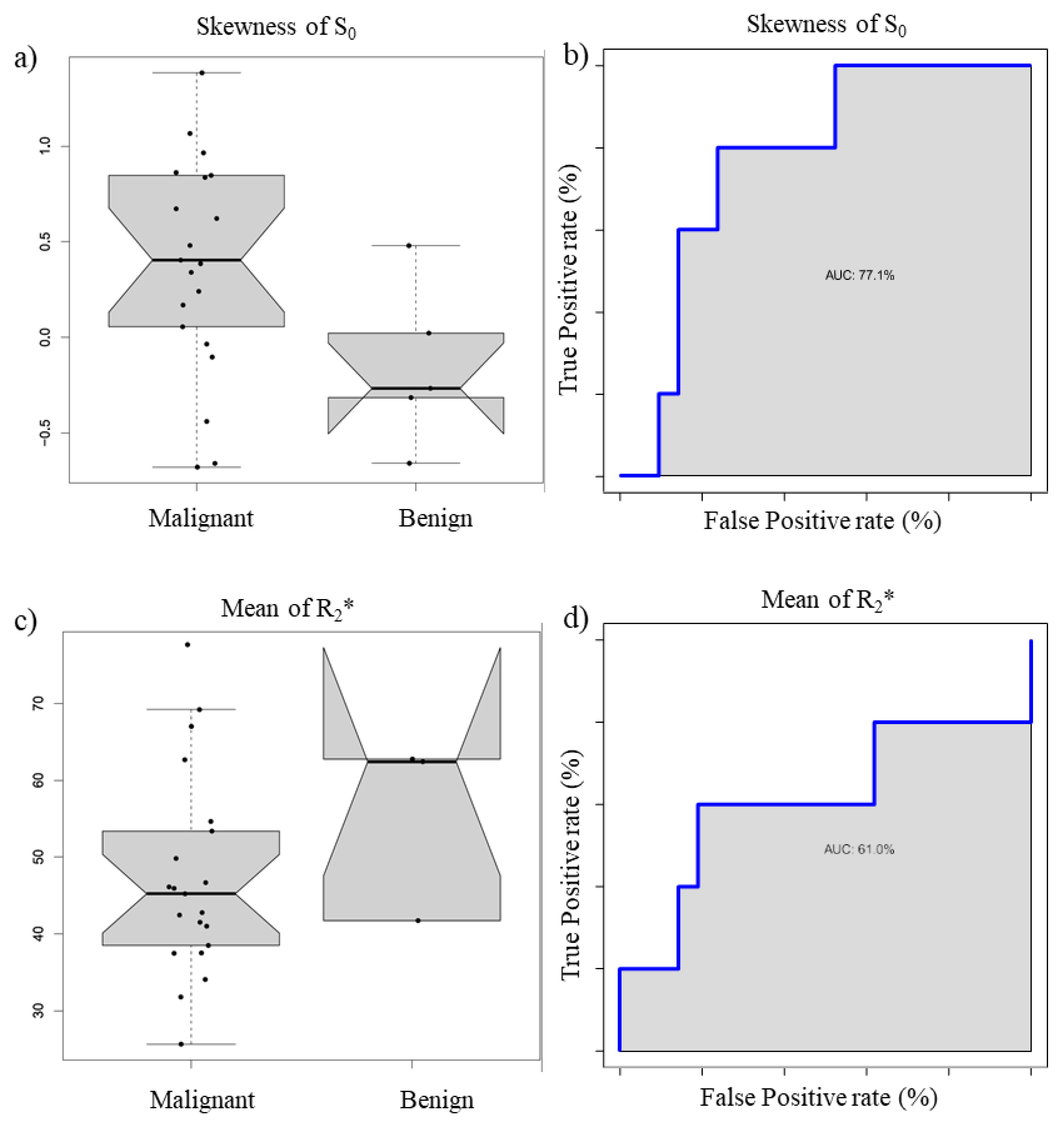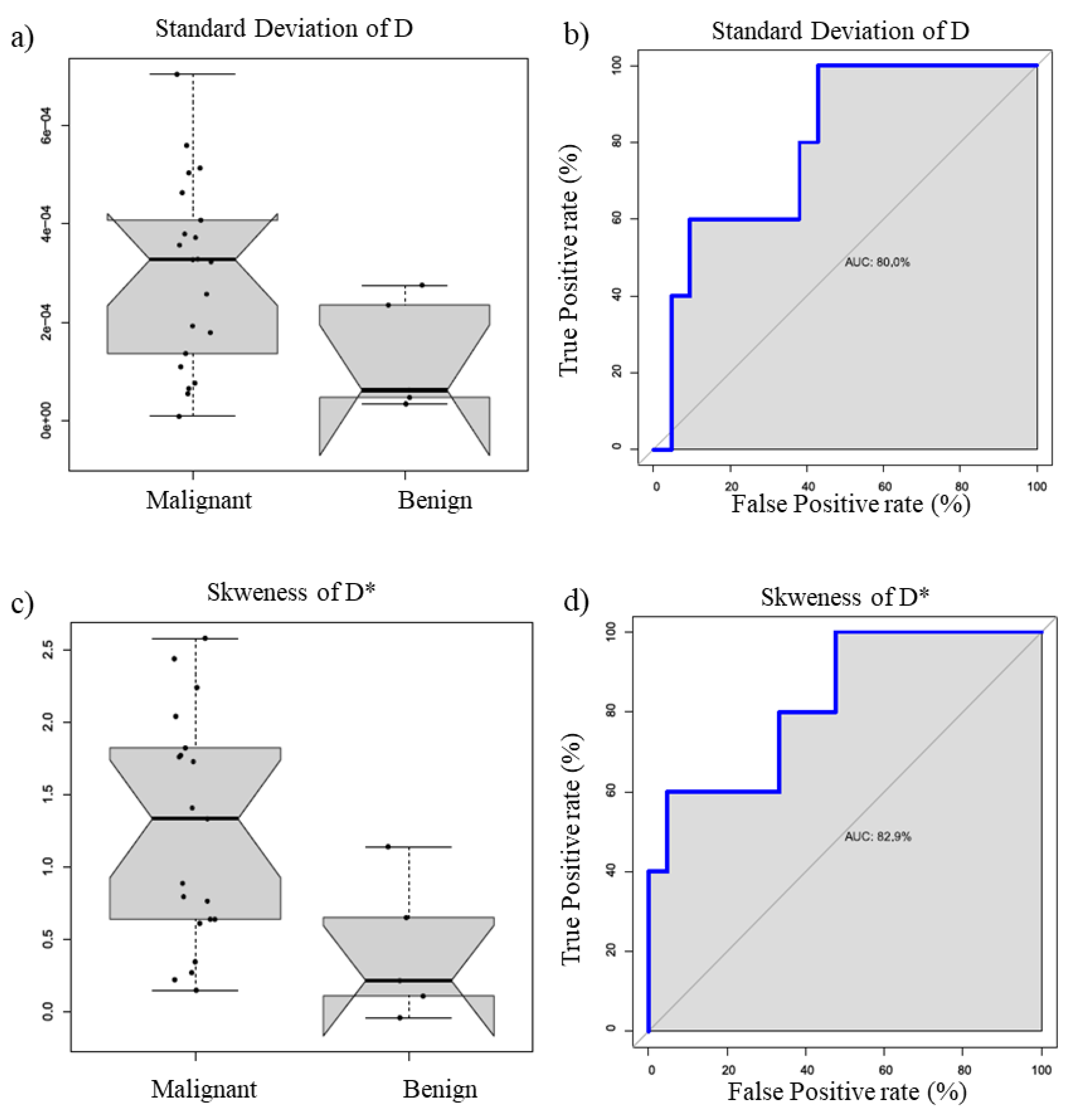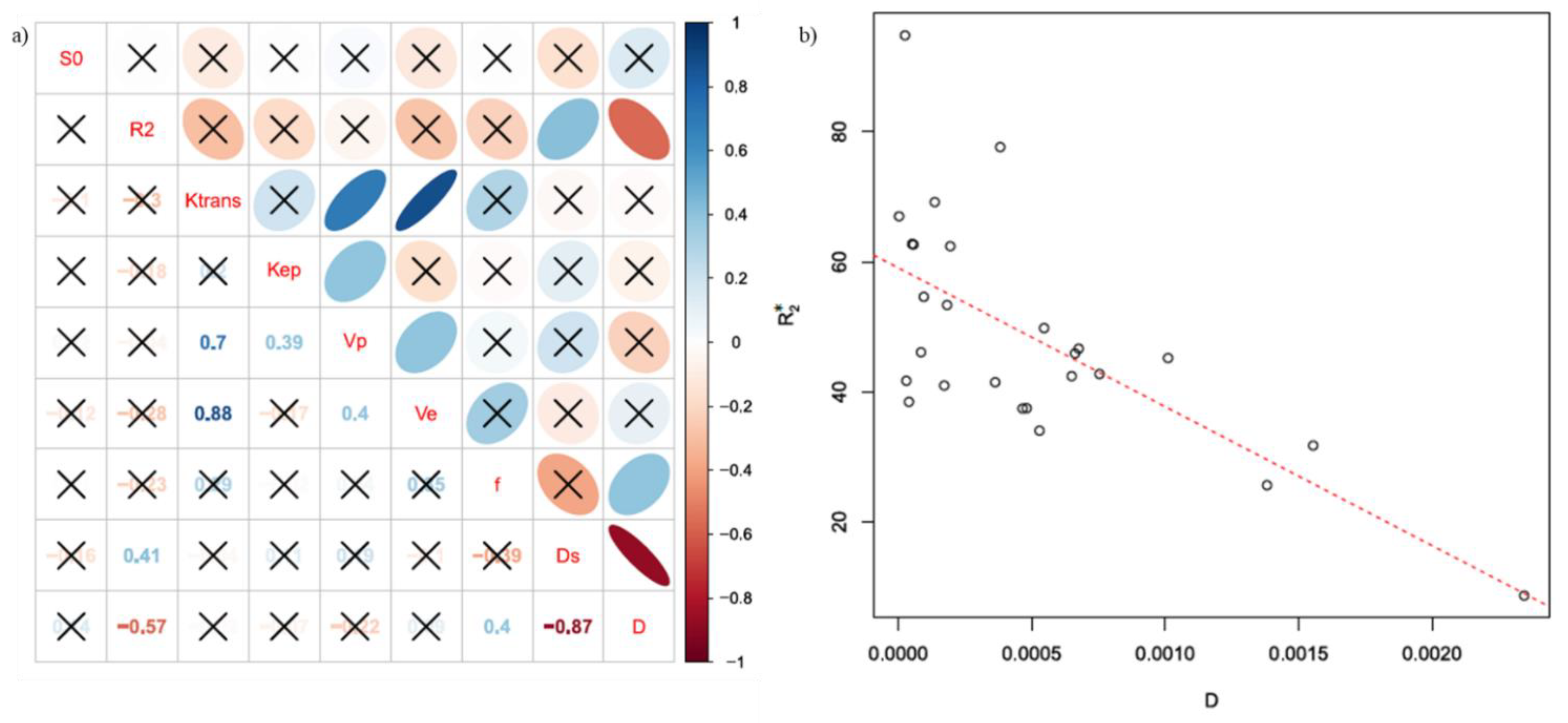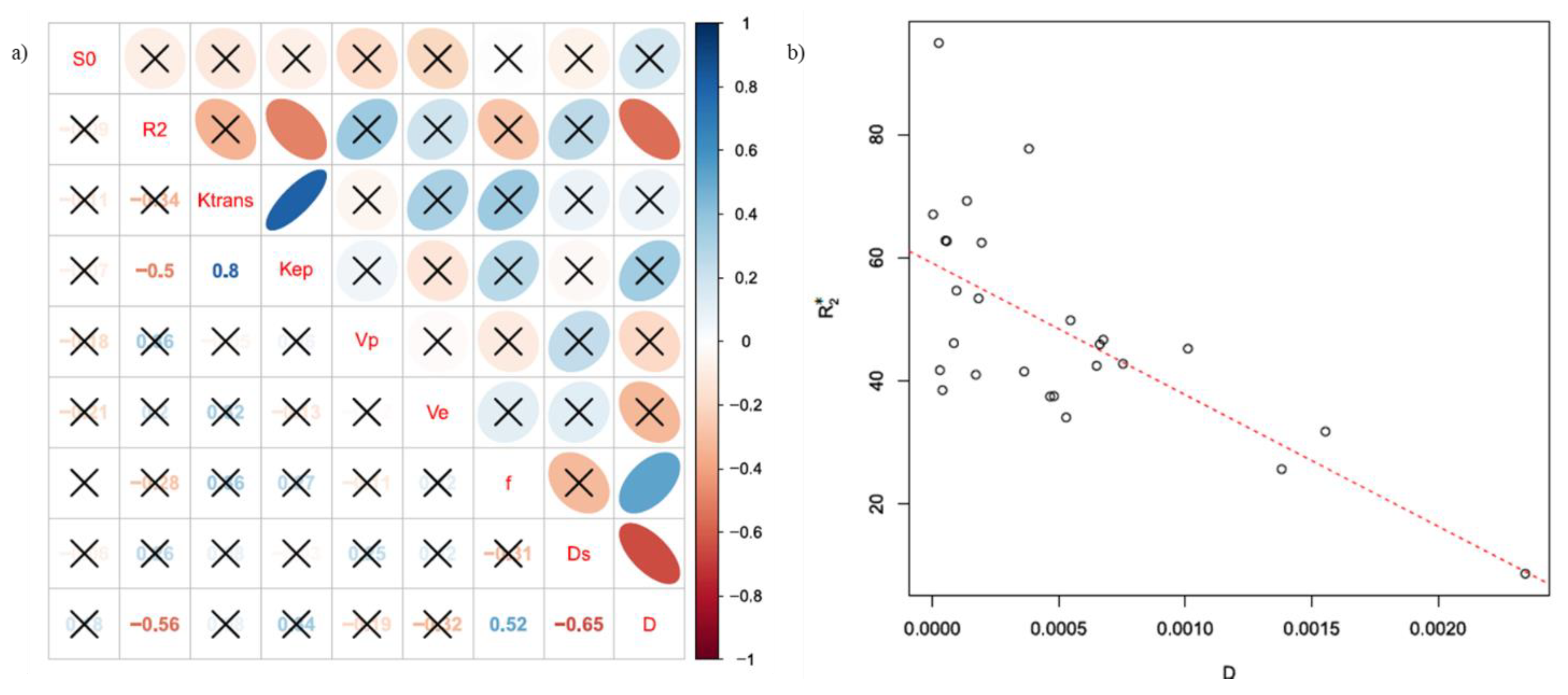Blood Oxygenation Level Dependent Magnetic Resonance Imaging (MRI), Dynamic Contrast Enhanced MRI, and Diffusion Weighted MRI for Benign and Malignant Breast Cancer Discrimination: A Preliminary Experience
Abstract
:Simple Summary
Abstract
1. Introduction
2. Methods
2.1. Patient Characteristics
2.2. MRI Protocol
2.3. Manual ROI and Volume Coregistration
2.4. BOLD Image Analysis
2.5. DW-MRI Image Analysis
2.6. DCE-MRI Image Analysis
2.7. Reference Standard and Pathological Methods
2.8. Statistical Analysis
2.8.1. Univariate Analysis
2.8.2. Multivariate Analysis
3. Results
3.1. Univariate Analysis Results
3.2. Multivariate Analysis Results
4. Discussion
5. Conclusions
Author Contributions
Funding
Institutional Review Board Statement
Informed Consent Statement
Data Availability Statement
Conflicts of Interest
References
- Sung, H.; Ferlay, J.; Siegel, R.L.; Laversanne, M.; Soerjomataram, I.; Jemal, A.; Bray, F. Global cancer statistics 2020: GLOBOCAN estimates of incidence and mortality worldwide for 36 cancers in 185 countries. CA Cancer J. Clin. 2021, 86, 394–424. [Google Scholar] [CrossRef]
- Sansone, M.; Fusco, R.; Petrillo, A.; Petrillo, M.; Bracale, M. An expectation-maximisation approach for simultaneous pixel classification and tracer kinetic modelling in dynamic contrast enhanced-magnetic resonance imaging. Med. Biol. Eng. Comput. 2011, 49, 485–495. [Google Scholar] [CrossRef] [Green Version]
- Fusco, R.; Petrillo, A.; Petrillo, M.; Sansone, M. Use of tracer kinetic models for selection of semi-quantitative features for DCE-MRI data classification. Appl. Magn. Reson. 2013, 44, 1311–1324. [Google Scholar] [CrossRef]
- Fusco, R.; Sansone, M.; Petrillo, A. A comparison of fitting algorithms for diffusion-weighted MRI data analysis using an intravoxel incoherent motion model. Magn. Reson. Mater. Physics Biol. Med. 2017, 30, 113–120. [Google Scholar] [CrossRef]
- Fusco, R.; Sansone, M.; Filice, S.; Granata, V.; Catalano, O.; Amato, D.M.; Bonito, M.D.; D’Aiuto, M.; Capasso, I.; Rinaldo, M.; et al. Integration of DCE-MRI and DW-MRI quantitative parameters for breast lesion classification. BioMed Res. Int. 2015, 237863. [Google Scholar] [CrossRef]
- Sardanelli, F.; Fausto, A.; Podo, F. MR spectroscopy of the breast. Radiol. Med. 2008, 113, 56–64. [Google Scholar] [CrossRef] [PubMed]
- Rami, R. Hallac Noninvasive Assessment of Human Tumor Hypoxia Using MRI in Clinical and Preclinical Tumor Models. Ph.D. Thesis, UT Southwestern Graduate School of Biomedical Sciences, Dallas, TX, USA, 2016. [Google Scholar]
- Hockel, M.; Vaupel, P. Tumor hypoxia: Definitions and current clinical, biologic, and molecular aspects. J. Natl. Cancer Inst. 2001, 93, 266–276. [Google Scholar] [CrossRef] [PubMed] [Green Version]
- Ogawa, S.; Lee, T.M.; Kay, A.R.; Tank, D.W. Brain magnetic resonance imaging with contrast dependent on blood oxygenation. Proc. Natl. Acad. Sci. USA 1990, 87, 9868–9872. [Google Scholar] [CrossRef] [Green Version]
- Silvennoinen, M.J.; Clingman, C.S.; Golay, X.; Kauppinen, R.A.; Van Zijl, P.C.M. Comparison of the dependence of blood R2 and on oxygen saturation at 1.5 and 4.7 Tesla. Magn. Reson. Med. 2003, 49, 47–60. [Google Scholar] [CrossRef]
- Zhao, J.M.; Clingman, C.S.; Närväinen, M.J.; Kauppinen, R.A.; Van Zijl, P.C.M. Oxygenation and hematocrit dependence of transverse relaxation rates of blood at 3 T. Magn. Reson. Med. 2007, 58, 592–597. [Google Scholar] [CrossRef] [PubMed]
- Blockley, N.P.; Jiang, L.; Gardener, A.G.; Ludman, C.N.; Francis, S.T.; Gowland, P.A. Field strength dependence of R1 and relaxivities of human whole blood to prohance, vasovist, and deoxyhemoglobin. Magn. Reson. Med. 2008, 60, 1313–1320. [Google Scholar] [CrossRef] [PubMed]
- Rakow-Penner, R.; Daniel, B.; Glover, G.H. Detecting blood oxygen level-dependent (BOLD) contrast in the breast. J. Magn. Reson. Imaging 2010, 32, 120–129. [Google Scholar] [CrossRef]
- Mcphail, L.D.; Robinson, S.P. Intrinsic susceptibility MR imaging of chemically induced rat mammary tumors: Relationship to histologic assessment of hypoxia and fibrosis. Radiology 2010, 254, 110–118. [Google Scholar] [CrossRef] [Green Version]
- Ercolani, P.; Giovagnoni, A.; Giuseppetti, G.; Baldassarre, S.; De Nigris, E.; Amici, F. Imaging dinamico con risonanza magnetica nella senologia diagnostica [Dynamic imaging with magnetic resonance in the diagnosis of breast disease]. Radiol. Med. 1991, 82, 422–426. [Google Scholar]
- Minutoli, F.; Pergolizzi, S.; Blandino, A.; Mormina, E.; Amato, E.; Gaeta, M. Effect of granulocyte colony-stimulating factor on bone marrow: Evaluation by Intravoxel incoherent motion and dynamic contrast-enhanced magnetic resonance imaging. Radiol. Med. 2020, 125, 280–287. [Google Scholar] [CrossRef]
- Pediconi, F.; Venditti, F.; Padula, S.; Roselli, A.; Moriconi, E.; Giacomelli, L.; Catalano, C.; Passariello, R. CE-Magnetic Resonance Mammography for the evaluation of the contralateral breast in patients with diagnosed breast cancer. Radiol. Med. 2005, 110, 61–68. [Google Scholar]
- Calabrese, M.; Brizzi, D.; Carbonaro, L.; Chiaramondia, M.; Kirchin, M.A.; Sardanelli, F. Contrast-enhanced breast MR imaging of claustrophobic or oversized patients using an open low-field magnet. Radiol. Med. 2009, 114, 267–285. [Google Scholar] [CrossRef] [PubMed]
- Trimboli, R.M.; Codari, M.; Khouri Chalouhi, K.; Ioan, I.; Lo Bue, G.; Ottini, A.; Casolino, D.; Carbonaro, L.A.; Sardanelli, F. Correlation between voxel-wise enhancement parameters on DCE-MRI and pathological prognostic factors in invasive breast cancers. Radiol. Med. 2018, 123, 91–97. [Google Scholar] [CrossRef] [PubMed]
- Ledermann, H.P.; Schulte, A.C.; Heidecker, H.G.; Aschwanden, M.; Jäger, K.A.; Scheffler, K.; Steinbrich, W.; Bilecen, D. Blood oxygenation level-dependent magnetic resonance imaging of the skeletal muscle in patients with peripheral arterial occlusive disease. Circulation 2006, 113, 2929–2935. [Google Scholar] [CrossRef] [Green Version]
- Wang, Y.; Liu, M.; Jin, M.L. Blood Oxygenation Level-dependent Magnetic Resonance Imaging of Breast Cancer: Correlation with Carbonic Anhydrase IX and Vascular Endothelial Growth Factor. Chin. Med. J. Engl. 2017, 130, 71–76. [Google Scholar] [CrossRef]
- Gibbs, P.; Liney, G.P.; Pickles, M.D.; Zelhof, B.; Rodrigues, G.; Turnbull, L.W. Correlation of ADC and T2 measurements with cell density in prostate cancer at 3.0 Tesla. Invest. Radiol. 2009, 44, 572–576. [Google Scholar] [CrossRef]
- Matsumoto, Y.; Kuroda, M.; Matsuya, R.; Kato, H.; Shibuya, K.; Oita, M.; Kawabe, A.; Matsuzaki, H.; Asaumi, J.; Murakami, J.; et al. In vitro experimental study of the relationship between the apparent diffusion coefficient and changes in cellularity and cell morphology. Oncol. Rep. 2009, 22, 641–648. [Google Scholar]
- Guo, Y.; Cai, Y.Q.; Cai, Z.L.; Gao, Y.G.; An, N.Y.; Ma, L.; Mahankali, S.; Gao, J.H. Differentiation of clinically benign and malignant breast lesions using diffusion-weighted imaging. J. Magn. Reason. Imaging 2002, 16, 172–178. [Google Scholar] [CrossRef] [PubMed]
- Woodhams, R.; Matsunaga, K.; Iwabuchi, K.; Kan, S.; Hata, H.; Kuranami, M.; Watanabe, M.; Hayakawa, K. Diffusion-weighted imaging of malignant breast tumors: The usefulness of apparent diffusion coefficient (ADC) value and ADC map for the detection of malignant breast tumors and evaluation of cancer extension. J. Comput. Assist. Tomogr. 2005, 29, 644–649. [Google Scholar] [CrossRef] [PubMed]
- Rahbar, H.; Partridge, S.C.; Eby, P.R.; Demartini, W.B.; Gutierrez, R.L.; Peacock, S.; Lehman, C.D. Characterization of ductal carcinoma in situ on diffusion weighed breast MRI. Eur. Radiol. 2011, 21, 2011–2019. [Google Scholar] [CrossRef] [PubMed]
- Tan, S.L.; Rahmat, K.; Rozalli, F.I.; Mohd-Shah, M.N.; Aziz, Y.F.; Yip, C.H.; Vijayananthan, A.; Ng, K.H. Differentiation between benign and malignant breast lesions using quantitative diffusion-weighted sequence on 3T MRI. Clin. Radiol. 2014, 69, 63–71. [Google Scholar] [CrossRef]
- Cohen-Adad, J. What can we learn from maps of the cortex? NeuroImage 2014, 93, 189–200. [Google Scholar] [CrossRef] [PubMed]
- Bihan, D.L.; Breton, E.; Lallemand, D.; Grenier, P.; Cabanis, E.; Laval-Jeantet, M. MR imaging of intravoxel incoherent motions: Application to diffusion and perfusion in neurologic disorders. Radiology 1986, 161, 401–407. [Google Scholar] [CrossRef] [Green Version]
- Bihan, D.L.; Breton, E.; Lallemand, D.; Aubin, M.L.; Vignaud, J.; Laval-Jeantet, M. Separation of diffusion and perfusion in intravoxel incoherentmotion MR imaging. Radiology 1988, 168, 497–505. [Google Scholar] [CrossRef]
- Bihan, D.L. What can we see with IVIM MRI? NeuroImage 2019, 187, 56–67. [Google Scholar] [CrossRef]
- Fusco, R.; Sansone, M.; Petrillo, A. The use of the levenberg-marquardt and variable projection curve-fitting algorithm in intravoxel incoherent motion method for DW-MRI data analysis. App. Magn. Reson. 2015, 46, 551–558. [Google Scholar] [CrossRef]
- Granata, V.; Fusco, R.; Sansone, M.; Grassi, R.; Maio, F.; Palaia, R.; Tatangelo, F.; Botti, G.; Grimm, R.; Curley, S.; et al. Magnetic resonance imaging in the assessment of pancreatic cancer with quantitative parameter extraction by means of dynamic contrast-enhanced magnetic resonance imaging, diffusion kurtosis imaging and intravoxel incoherent motion diffusion-weighted imaging. Therap. Adv. Gastroenterol. 2020. [Google Scholar] [CrossRef]
- Tofts, P.S. Modeling tracer kinetics in dynamic Gd-DTPA MR imaging. J. Magn. Reson. Imaging. 1997, 7, 91–101. [Google Scholar] [CrossRef] [PubMed]
- Yang, C.; Karczmar, G.S.; Medved, M.; Stadler, W.M. Estimating the arterial input function using two reference tissues in dynamic contrast-enhanced MRI studies: Fundamental concepts and simulations. Magn. Reson. Med. 2004, 52, 1110–1117. [Google Scholar] [CrossRef] [PubMed]
- Weinmann, H.J.; Laniado, M.; Mützel, W. Pharmacokinetics of GdDTPA/dimeglumine after intravenous injection into healthy volunteers. Physiol. Chem. Phys. Med. NMR 1984, 16, 167–172. [Google Scholar]
- Jiang, L.; Weatherall, P.T.; McColl, R.W.; Tripathy, D.; Mason, R.P. Blood oxygenation level-dependent (BOLD) contrast magnetic resonance imaging (MRI) for prediction of breast cancer chemotherapy response: A pilot study. J. Magn. Reson. Imaging 2013, 37, 1083–1092. [Google Scholar] [CrossRef]
- Schabel, M.C.; Morrell, G.R.; Oh, K.Y.; Walczak, C.A.; Barlow, R.B.; Neumayer, L.A. Pharmacokinetic mapping for lesion classification in dynamic breast MRI. J. Magn. Reson. Imaging 2010, 31, 1371–1378. [Google Scholar] [CrossRef] [Green Version]
- R-Tools Technology Inc.© Copyright 2000–2020. Available online: https://www.r-tt.com/ (accessed on 20 April 2020).
- He, H.; Bai, Y.; Garcia, E.; Li, S. ADASYN: Adaptive Synthetic Sampling Approach for Imbalanced Learning. In Proceedings of the International Joint Conference on Neural Networks, Hong Kong, 1–8 June 2008; pp. 1322–1328. [Google Scholar] [CrossRef] [Green Version]
- Chawla, N.V.; Bowyer, K.W.; Hall, L.O.; Kegelmeyer, W.P. SMOTE: Synthetic minority oversampling technique. J. Artif. Intell. Res. 2002, 16, 321–357. [Google Scholar] [CrossRef]
- Mao, X.; Zou, X.; Yu, N.; Jiang, X.; Du, J. Quantitative evaluation of intravoxel incoherent motion diffusion-weighted imaging (IVIM) for differential diagnosis and grading prediction of benign and malignant breast lesions. Medicine 2018, 97, e11109. [Google Scholar] [CrossRef]
- Liu, C.; Liang, C.; Liu, Z.; Zhang, S.; Huang, B. Intravoxel incoherent motion (IVIM) in evaluation of breast lesions: Comparison with conventional DWI. Eur. J Radiol. 2013, 82, e782–e789. [Google Scholar] [CrossRef]
- Kostourou, V.; Robinson, S.P.; Whitley, G.S.; Griffiths, J.R. Effects of overexpression of dimethylarginine dimethylaminohydrolase on tumor angiogenesis assessed by susceptibility magnetic resonance imaging. Cancer Res. 2003, 63, 4960–4966. [Google Scholar]
- Vaupel, P.; Schlenger, K.; Knoop, C.; Höckel, M. Oxygenation of human tumors: Evaluation of tissue oxygen distribution in breast cancers by computerized O2 tension measurements. Cancer Res. 1991, 51, 3316–3322. [Google Scholar]
- Zhao, D.; Jiang, L.; Hahn, E.W.; Mason, R.P. Comparison of 1H blood oxygen level-dependent (BOLD) and 19F MRI to investigate tumor oxygenation. Magn. Reson. Med. 2009, 62, 357–364. [Google Scholar] [CrossRef] [PubMed] [Green Version]
- Fusco, R.; Granata, V.; Pariante, P.; Cerciello, V.; Siani, C.; Bonito, M.D.; Valentino, M.; Sansone, M.; Botti, G.; Petrillo, A. Blood oxygenation level dependent magnetic resonance imaging and diffusion weighted MRI imaging for benign and malignant breast cancer discrimination. Magn. Reson. Imaging 2021, 75, 51–59. [Google Scholar] [CrossRef] [PubMed]
- Rahbar, H.; Partridge, S.C.; Demartini, W.B.; Gutierrez, R.L.; Allison, K.H.; Peacock, S.; Lehman, C.D. In vivo assessment of ductal carcinoma in situ grade: A model incorporating dynamic contrast-enhanced and diffusion-weighted breast MR imaging parameters. Radiology 2012, 263, 374–382. [Google Scholar] [CrossRef] [PubMed]
- Partridge, S.C.; DeMartini, W.B.; Kurland, B.F.; Eby, P.R.; White, S.W.; Lehman, C.D. Quantitative diffusion-weighted imaging as an adjunct to conventional breast MRI for improved positive predictive value. AJR Am. J. Roentgenol. 2009, 193, 1716–1722. [Google Scholar] [CrossRef]
- Jena, A.; Taneja, S.; Mehta, S.B. Integrated quantitative DCE-MRI and DW-MRI to characterize breast lesions. Eur. J. Radiol. 2012, 81, S64–S65. [Google Scholar] [CrossRef]
- Lee, J.T.; Liau, J.; Murphy, P.; Schroeder, M.E.; Sirlin, C.B.; Bydder, M. Cross-sectional investigation of correlation between hepatic steatosis and IVIM perfusion on MR imaging. Magn. Reson. Imaging 2012, 30, 572–578. [Google Scholar] [CrossRef] [Green Version]






| Settings | DCE-MRI | BOLD-MRI | DW-MRI | Units |
|---|---|---|---|---|
| TR/TE/FA | 5.08/2.39/15 | 358/4–40.187/40 | 7700/128/90 | ms/ms/deg |
| Plane | Axial | Sagittal | Axial | |
| FOV | 500 × 500 | 211 × 260 | 203 × 400 | mm2 |
| Matrix size | 384 × 384 | 104 × 128 | 120 × 236 | pixel |
| Pixel spacing | 0.885 × 0.885 | 2.03 × 2.03 | 1.69 × 1.69 | mm2 |
| Slice thickness | 1.60 | 6 | 4 | mm |
| Gap between slices | 0 | 7.2 | 6 | mm |
| No. of slices | 128 | 80 | 168 | - |
| S 0[A.U.]H | R2* [Hz] | D [104 mm2 s−1] | f [%] | D* [104 mm2 s−1] | Ktrans [1/min] | kep [1/min] | vp [%] | ve [%] | ||
|---|---|---|---|---|---|---|---|---|---|---|
| Benign | Mean | 506.0 | 54.1 | 5.3 | 9.1 | 48.6 | 0.1 | 0.8 | 0.2 | 12.8 |
| Standard Deviation | 57.3 | 31.7 | 10.2 | 4.9 | 15.2 | 0.0 | 0.3 | 0.2 | 5.3 | |
| Malignant | Mean | 578.0 | 45.2 | 4.9 | 9.4 | 34.6 | 0.2 | 0.5 | 0.5 | 36.4 |
| Standard Deviation | 242.0 | 13.0 | 4.3 | 3.8 | 14.1 | 0.1 | 0.2 | 0.4 | 15.5 | |
| Total | Mean | 564.0 | 48.5 | 5.0 | 9.3 | 37.3 | 0.2 | 0.6 | 0.4 | 31.9 |
| Standard Deviation | 220.0 | 17.5 | 5.6 | 3.9 | 15.1 | 0.1 | 0.3 | 0.4 | 16.9 |
| S0 [A.U.] | R2* [Hz] | D [104 mm2 s−1] | f [%] | D* [104 mm2 s−1] | Ktrans [1/min] | kep [1/min] | vp [%] | ve [%] | ||
|---|---|---|---|---|---|---|---|---|---|---|
| Benign | Mean | 487.0 | 47.8 | 5.1 | 8.6 | 34.8 | 0.0 | 0.1 | 0.3 | 46.2 |
| Standard Deviation | 62.9 | 26.0 | 10.2 | 5.3 | 24.8 | 0.0 | 0.1 | 0.3 | 30.0 | |
| Malignant | Mean | 555.0 | 41.9 | 4.3 | 9.3 | 24.4 | 0.2 | 0.3 | 0.2 | 44.4 |
| Standard Deviation | 233.0 | 11.3 | 3.9 | 5.1 | 23.4 | 0.2 | 0.2 | 0.3 | 19.2 | |
| Total | Mean | 542.0 | 43.0 | 4.4 | 9.2 | 26.4 | 0.1 | 0.3 | 0.2 | 44.7 |
| Standard Deviation | 212.0 | 14.7 | 5.4 | 5.0 | 23.6 | 0.1 | 0.2 | 0.3 | 20.6 |
| p Value at Wilcoxon-Mann-Whitney U-Test | Mean | Standard Deviation | Skewness | Kurtosis |
|---|---|---|---|---|
| S0 | 0.90 | 0.71 | 0.05 | 0.11 |
| R2∗ | 0.08 | 0.75 | 0.14 | 0.09 |
| Ktrans | 0.05 | 0.22 | 0.37 | 0.20 |
| kep | 0.04 | 0.04 | 0.03 | 0.18 |
| vp | 0.34 | 0.18 | 0.41 | 0.37 |
| ve | 0.00 | 0.07 | 0.01 | 0.01 |
| f | 0.95 | 0.22 | 0.06 | 0.22 |
| D | 0.22 | 0.04 | 0.31 | 0.06 |
| D∗ | 0.08 | 0.53 | 0.02 | 0.04 |
Publisher’s Note: MDPI stays neutral with regard to jurisdictional claims in published maps and institutional affiliations. |
© 2021 by the authors. Licensee MDPI, Basel, Switzerland. This article is an open access article distributed under the terms and conditions of the Creative Commons Attribution (CC BY) license (https://creativecommons.org/licenses/by/4.0/).
Share and Cite
Fusco, R.; Granata, V.; Mattace Raso, M.; Vallone, P.; De Rosa, A.P.; Siani, C.; Di Bonito, M.; Petrillo, A.; Sansone, M. Blood Oxygenation Level Dependent Magnetic Resonance Imaging (MRI), Dynamic Contrast Enhanced MRI, and Diffusion Weighted MRI for Benign and Malignant Breast Cancer Discrimination: A Preliminary Experience. Cancers 2021, 13, 2421. https://doi.org/10.3390/cancers13102421
Fusco R, Granata V, Mattace Raso M, Vallone P, De Rosa AP, Siani C, Di Bonito M, Petrillo A, Sansone M. Blood Oxygenation Level Dependent Magnetic Resonance Imaging (MRI), Dynamic Contrast Enhanced MRI, and Diffusion Weighted MRI for Benign and Malignant Breast Cancer Discrimination: A Preliminary Experience. Cancers. 2021; 13(10):2421. https://doi.org/10.3390/cancers13102421
Chicago/Turabian StyleFusco, Roberta, Vincenza Granata, Mauro Mattace Raso, Paolo Vallone, Alessandro Pasquale De Rosa, Claudio Siani, Maurizio Di Bonito, Antonella Petrillo, and Mario Sansone. 2021. "Blood Oxygenation Level Dependent Magnetic Resonance Imaging (MRI), Dynamic Contrast Enhanced MRI, and Diffusion Weighted MRI for Benign and Malignant Breast Cancer Discrimination: A Preliminary Experience" Cancers 13, no. 10: 2421. https://doi.org/10.3390/cancers13102421






